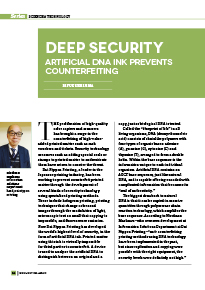Home > Highlighting JAPAN >Highlighting Japan February 2015>Science & Technology
Highlighting JAPAN

Science & Technology
Deep Security
Artificial DNA ink prevents counterfeiting

The proliferation of high-quality color copiers and scanners has brought a surge in the counterfeiting of high-value-added printed matter such as cash vouchers and tickets. Security technology measures such as adding special seals or stamps to printed matter to authenticate them have arisen to counter the threat.
Dai Nippon Printing, a leader in the Japanese printing industry, has been working to prevent counterfeit printed matter through the development of several kinds of security technology using specialized printing methods. These include hologram printing, printing techniques that change colors and images through the modulation of light, microscopic text so small that copying is impossible, and fluorescence emission. Now Dai Nippon Printing has developed the world’s highest level of security, in the form of artificial DNA ink. Printed matter using this ink is virtually impossible for third parties to counterfeit. A device is used to analyze the artificial DNA to distinguish between an original and a copy, just as biological DNA is tested.
Called the “blueprint of life” in all living organisms, DNA (deoxyribonucleic acid) consists of chainlike polymers with four types of organic bases: adenine (A), guanine (G), cytosine (C) and thymine (T), arranged to form a double helix. Within the base sequence is the information unique to each individual organism. Artificial DNA contains an AGCT base sequence, just like natural DNA, and is capable of being encoded with complicated information that becomes its “seal of authenticity.”
The biggest drawback to natural DNA is that it can be copied in massive quantities through polymerase chain reaction technology, which amplifies the base sequence. According to Hirokazu Maekawa—who oversees development at Information Solutions Department at Dai Nippon Printing—“anti-counterfeiting printing methods using DNA technology have been implemented in the past, but since replication and copying were possible with the right equipment, the security levels were definitely not high.” Furthermore, the technology was vulnerable to light, high heat and high humidity, making its integrity susceptible to damage by the environment.
TagCyx Biotechnologies—a venture company formed by the Institute of Physical and Chemical Research, Japan (known as RIKEN)—created the artificial DNA used in Dai Nippon Printing's version of artificial DNA ink. The ink adds proprietarily developed synthetic base pairs to the four organic AGTC bases. The synthetic base pairs, which are the key to this technology, cannot be analyzed without specialized knowledge, making replication and copying impossible, which is almost like putting a lock in the artificial DNA.
Regarding the issue of environmental durability, artificial DNA was modified to withstand light and high heat by manipulating the base sequence. Furthermore, through printing technology—a Dai Nippon Printing specialty—that involves coating the surface of printed matter with protective ink, the artificial DNA is protected and made less susceptible to environmental factors.
Printed matter using artificial DNA ink can be authenticated within twelve hours using analytic equipment. Currently, however, it is necessary to send the printed matter to specialized facilities to conduct this DNA analysis, so “to proliferate this technology, the task at hand is to create a system for easy authentication,” says Maekawa. To address this issue, he is working to develop an analysis kit that allows simplified authentication to be conducted easily and anywhere.
By using artificial DNA, the security of high-value-added printed matter such as passports and securities can be greatly improved, and assist in crime prevention as well. With several countries expressing interest in its use as an anti-counterfeiting method for paper currency, the technology has attracted interest around the world as a next-generation printing security measure.
© 2009 Cabinet Office, Government of Japan






